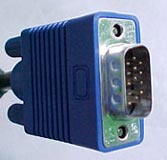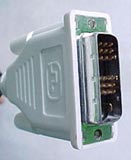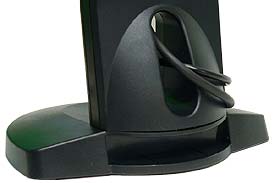| Analog Connection |
DVI Connection |
 |
 |
|
Supported on 171B |
Not Supported |
Analog video connections are the type
of VGA interface most commonly in use at the moment. The 171B only
offers support for an Analog connection.
The basic differences between an analog display adapter and a DVI (digital) display
adapter is that with the blue analog cable, the image is transmitted to your monitor as an
analog signal.
On the DVI cable, the images arrives
at the display as a digital stream of one's and zero's. When these display signals are
sent to an LCD display via an analog cable, the picture must be translated to
a digitally signal before it can be processed and shown.
On the other hand, if you happen to have a digital
DVI output on your video card, the digital signals are simply sent right to
the display to be shown on the screen. Is there a difference between the two ways of connecting to
a LCD display? Well yes an no. On the visual level there are not
that many user perceivable difference in display quality, but I've been told they exist.
Extra Bits and Pieces:
While I could tell you volumes about how the 171B has a
nice little spot on the back of the stand for a self-powered USB hub, I can't
tell you much more, because it is an optional add-on and was not included with
our review unit. Still, I would guess that the hub has four ports, and
makes the life of people with USB printers, mice, and keyboards all that much easier.

